ASUS TUF Gaming Z590-Plus WIFI Motherboard Review: Is $260 Mid-Range or High-End?
by Gavin Bonshor on August 10, 2021 10:00 AM ESTVisual Inspection
When ASUS rebranded its TUF series back in 2017 to supplement its already large gaming range of motherboards, it changed the aesthetic. Over the years, the TUF Gaming series has changed to what we have today with a slightly more subtle design for Z590 over previous generations. Looking at the PCB, ASUS is using a black and grey accented patterned design, with black heatsinks throughout, including a contrasting black chipset heatsink with the ASUS TUF logo embossed onto it. ASUS does include integrated RGB LEDs, but they glow from the right-hand side of the board. It does include two AURA addressable and two AURA RGB headers for users to add more if they so wish.
ASUS also includes ample cooling capabilities with the TUF Gaming Z590-Plus WIFI, including six 4-pin headers in total. This includes one for a CPU fan, one for an optional CPU fan, one for an AIO pump, and three for chassis fans. Other notable headers include a Thunderbolt header (for users to install an add-in-card, purchased separately), a clear CMOS header and a COM port.
The ASUS TUF Gaming Z590-Plus WIFI includes one full-length PCIe 4.0 x16 slot, with a second full-length PCIe 3.0 x4 slot, and two PCIe 3.0 x1 slots. Touching more on storage options, ASUS includes three M.2 slots onboard, including one with support for PCIe 4.0 x4 M.2 drives, and two with support for PCIe 3.0 x4 and SATA M.2 drives. For SATA, there are six ports in total, with two right-angled connectors nestled into the cutout on the PCB on the right, and the remaining four with straight angled connectors in the bottom right-hand corner.
In the top right-hand corner is the board's memory slots, which includes four slots with support for up to DDR4-5133 when using Rocket Lake. Support is slightly different when using Comet Lake, which ASUS lists as DDR4-3200, but it shouldn't be a problem running DDR4-4000+ with Intel's 10th gen. Users can install up to 128 GB across the four slots, and memory will operate in dual channel with 2/4 sticks installed.
Taking a deeper look at the power delivery on the ASUS TUF Gaming Z590-Plus WIFI, it is using a large 14+2 design. The CPU section is using fourteen ON Semiconductor NCP302150 50 A power stages in a teamed configuration. This means the fourteen phases for the CPU are in fact operating with seven channels but without doublers. This is the same method employed on the SoC section, which includes two ON Semiconductor NCP302150 50 A power stages operating in a teamed array. The power delivery is controlled by a Digi+ ASP1900B PWM controller operating at 7+1. Providing power to the CPU is an 8-pin and 4-pin 12V ATX EPS 12V power input pairing.
Keeping the power delivery cool is a pair of VRM black metal heatsinks, one smaller one and a larger one which doubles up as a rear panel cover. ASUS is using deep channeled grooves in the metal to catch passive airflow within a system. The impressions on the thermal pads show that they are making good contact with the power delivery components.
Focusing on the audio solution on the TUF Gaming Z590-Plus WIFI, ASUS is using a Realtek ALC S1200A HD audio codec, which is assisted by five Japanese Nichicon gold audio capacitors. ASUS also includes a front panel audio header. The codec itself is covered by a small square metal EMI shield, with a line of PCB separation to reduce electromagnetic interference from outside sources and from the rest of the board's components.
On the rear panel is a varied selection of input and output, which is spearheaded by one USB 3.2 G2x2 Type-C, two USB 3.2 G2 Type-A, two USB 3.2 G1 Type-A, and two USB 2.0 ports. For users looking to leverage integrated graphics, there's an HDMI 2.0 and DisplayPort 1.4 video output pairing, while ASUS includes a PS/2 combo port for legacy peripherals. For onboard audio, there are five color-coded 3.5 mm audio jacks and S/PDIF optical output which is powered by a Realtek ALC S1200A HD audio codec. Focusing on networking, ASUS includes an Intel AX201 Wi-Fi 6 CNVi, as well as an Intel I225-V 2.5 GbE controller.
What's in The Box
The most notable accessories included within the bundle are a pair of SATA cables, an ASUS Wi-Fi 6 antenna, two M.2 installation screw kits, a user manual, and a support DVD. For users who like to jazz up their systems, ASUS also includes a TUF Gaming themed sticker sheet.
- 2 x black SATA cables
- ASUS Wi-Fi antenna
- 2 x M.2 rubber packages
- 2 x M.2 installation screws
- 2 x M.2 installation standoffs
- TUF Gaming sticker sheet
- User manual
- Support DVD
- TUF certification card


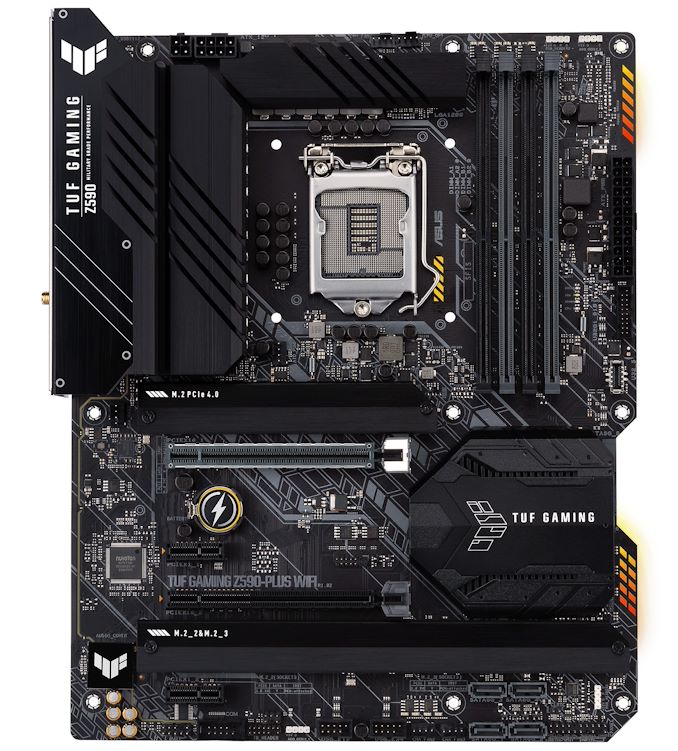
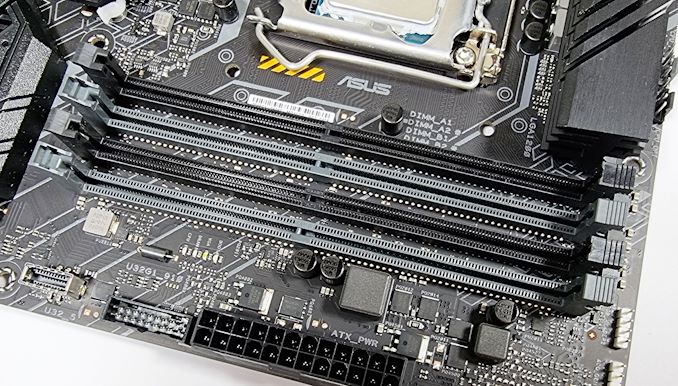
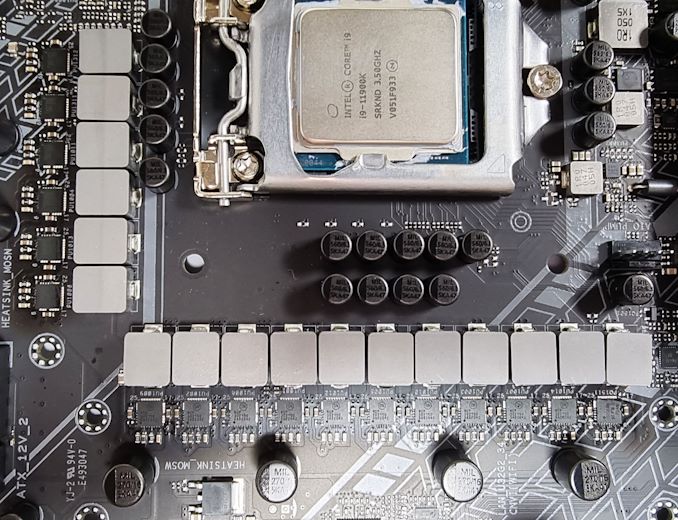
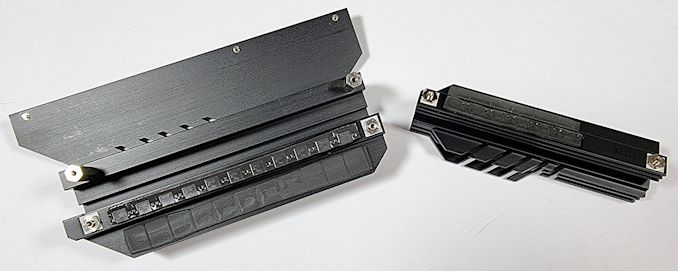
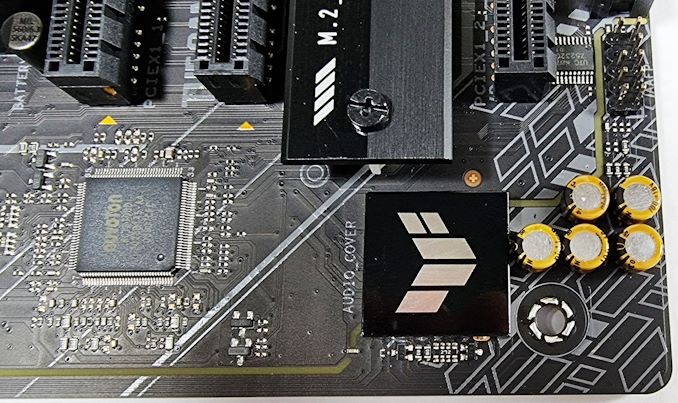

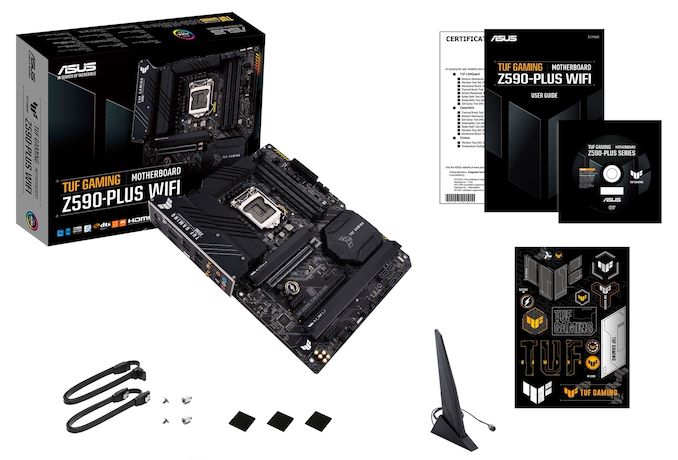








23 Comments
View All Comments
Arcadianu9 - Tuesday, August 10, 2021 - link
I would have liked to see the performance with one of the faster M.2 storage devices, and different configurations across the PCIe Gen4 and Gen3 connectors. The Crucial MX300 appears to be a SATA drive, which leaves a ton of performance on the table.Leeea - Tuesday, August 10, 2021 - link
What is weird about this is the ASUS TUF Gaming X570-PRO (WiFi 6) is both cheaper at $220 and is superior.That $40 difference also goes a long way to cover the difference in cost between
Wrs - Tuesday, August 10, 2021 - link
That’s AMD. The pins are on the CPU so the CPU is more expensive to match. Additionally Rocket Lake draws more instantaneous current so the boards need more VRMs. The AMD board’s second slot is PCIe-4, but it’s missing the third M2 slot as well as front USB-CLeeea - Tuesday, August 10, 2021 - link
The x570-Pro has the front and back USB-C ports. ( I have one sitting two feet from me )It also has 2x more SATA lines, BIOS flashback, PCIe 4 slots, multiple graphics card slots (the reviewed board indicates it only has one), and both m2 slots are PCIe 4.
The additional m2 slot on the z590 is an advantage, but cheap adaptors exist for converting PCIe 4.0 slots to m.2.
Yea, the different socket does cost more then the AMD equivalent, but ironically the CPU the board was reviewed with, the i9-11900K, costs a $150 more then its AMD equivalent 5800x.
Wrs - Tuesday, August 10, 2021 - link
Whoops, sorry about the USB-C front.For price comparisons I'd never match AMD's mid-range to Intel's top-end. The mobo+CPU comparison is far closer between 5800X/Z570 and 11700KF/Z590. The nice thing is street prices have been adjusting to relative performance & availability. Intel is obviously sweating on 14nm as they don't have any 12- or 16-core K competitor, plus they're cutting Rocket Lake below MSRP as it merely throws punches vs. a 5800x and is a bit behind in gaming and very much in power efficiency.
The PCI-e 4 lanes on x570 aren't always an advantage here, btw. See, Ryzen 3000 & 5000 only have 24 PCIe-4 lanes coming out of the SOC. In the TUF series, 16 are used for the first graphics slot and 4 for the first M2 slot, leaving 4 for the chipset to spread out between the second x16 graphics slot, second M2, and many of those USB links and Wifi. On Rocket Lake, 20 PCIe-4 lanes are used for the same graphics and M2 slots, but then 8 PCIe-3 lanes go to the chipset. The second x16 slot on both TUF boards is electrically just x4, but on the Intel version the halved bandwidth is accompanied by much less resource contention. This is primarily evident if you're using both a second M2 and multiple PCI-e cards on both boards - the simultaneous bandwidth off the chipsets is identical.
Leeea - Wednesday, August 11, 2021 - link
If I could upvote your post I would. :)supdawgwtfd - Wednesday, August 11, 2021 - link
8x gen3 lanes have the same bandwidth as 4x gen 4 lanes.Based on your comments the choosers would have the same bandwidth to the CPU?
What point we're you tryjg to make?
Threska - Tuesday, August 10, 2021 - link
"Although the aforementioned competitor's models include better onboard audio solutions, the ASUS and its lower price puts it in a solid position for users looking for a sub $300 model to build a Rocket Lake based system."But how many use the onboard audio anyway? Even the GPU has an onboard solution.
neothe0ne - Tuesday, August 10, 2021 - link
The vast majority of desktop computers use onboard sound from the motherboard. I'd guess that the market for cheap (e.g., sub-$150) DAC's/cards is just for people who buy a motherboard with a subpar Realtek audio implementation that lets them hear all their computer noise crystal clear.Operandi - Tuesday, August 10, 2021 - link
This isn't the early 00s DACs are easy these days as is evident by how many people use onboard audio (even with decent headphones or speakers) which is nearly everyone.